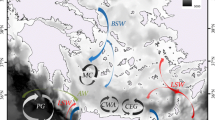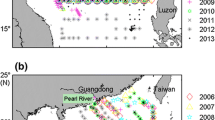Abstract
In this work, the hydrodynamic picture of the South Aegean Sea is examined through an analysis of recent measurements in its sub-basins, the Myrtoan and Cretan Sea. Both sub-basins play an important role in the water circulation, exchange, and formation processes that affect the dynamics of the whole Eastern Mediterranean. For the first time, Bio-Argo floats were deployed in the area under the Greek Argo Research Infrastructure coordination. The acquired profiles cover an almost 2-year period (November 2013–July 2015) and are compared with previous Argo profiles and the re-processed time-series data recorded from the E1-M3A POSEIDON observatory operating in the area since 2007. The spatio-temporal distribution of the physical and chemical properties in each sub-basin is examined. Dense water formation events are revealed in the northern part (Myrtoan), while the wider area can be characterized as pre-conditioned. In the Cretan basin, a strong inter-annual variability of the salinity field at intermediate and deep layers is observed that is associated with water exchange from its open boundaries. Furthermore, comparison of the dissolved oxygen (DO) distribution with physical water properties within both the mixed layer, and at greater depths, indicated that relatively high but still under-saturated DO values are more likely to be associated with convection events. Finally, an updated picture of the physical properties and the DO distribution is presented based on the last 5 years of measurements and the recent introduction of Bio-Argo floats with DO sensors in the area.














Similar content being viewed by others
References
Astraldi M, Balopoulos S, Candela J, et al. (1999) The role of straits and channels in understanding the characteristics of Mediterranean circulation. Prog Oceanogr 44:65–108. doi:10.1016/S0079-6611(99)00021-X
Balopoulos ET, Theocharis A, Kontoyiannis H, et al. (1999) Major advances in the oceanography of the southern Aegean Sea–Cretan Straits system (eastern Mediterranean. Prog Oceanogr 44:109–130. doi:10.1016/S0079-6611(99)00022-1
Bergamasco A, Malanotte-Rizzoli P (2010) The circulation of the Mediterranean Sea: a historical review of experimental investigations. Adv Oceanogr Limnol 1:11–28. doi:10.1080/19475721.2010.491656
Broecker WS, Peng T-H (1974) Gas exchange rates between air and sea1. Tellus 26:21–35. doi:10.1111/j.2153-3490.1974.tb01948.x
Cardin V, Gacic M, Nittis K, et al. (2003) Sub-inertial variability in the Cretan Sea from the M3 A buoy. Ann Geophys 21:89–102. doi:10.5194/angeo-21-89-2003
Cardin V, Civitarese G, Hainbucher D, et al. (2015) Thermohaline properties in the Eastern Mediterranean in the last three decades: is the basin returning to the pre-EMT situation? Ocean Sci 11:53–66. doi:10.5194/os-11-53-2015
Clarke RA, Coote AR (1988) The formation of Labrador Sea Water. Part III: the evolution of oxygen and nutrient concentration. J Phys Oceanogr 18:469–480. doi:10.1175/1520-0485(1988)018<0469:TFOLSW>2.0.CO;2
de Boyer Montégut C, Madec G, Fischer AS, et al. (2004) Mixed layer depth over the global ocean: an examination of profile data and a profile-based climatology. J Geophys Res Oceans 109:C12003. doi:10.1029/2004JC002378
Garcia HE, Gordon LI (1992) Oxygen solubility in seawater: better fitting equations. Limnol Oceanogr 37:1307–1312. doi:10.4319/lo.1992.37.6.1307
Gotsis-Skretas O, Pagou K, Moraitou-Apostolopoulou M, Ignatiades L (1999) Seasonal horizontal and vertical variability in primary production and standing stocks of phytoplankton and zooplankton in the Cretan Sea and the straits of the Cretan Arc (March 1994–January 1995. Prog Oceanogr 44:625–649. doi:10.1016/S0079-6611(99)00048-8
Ignatiades L (1998) The productive and optical status of the oligotrophic waters of the Southern Aegean Sea (Cretan Sea), Eastern Mediterranean. J Plankton Res 20:985–995
Ignatiades L, Psarra S, Zervakis V, et al. (2002) Phytoplankton size-based dynamics in the Aegean Sea (Eastern Mediterranean. J Mar Syst 36:11–28. doi:10.1016/S0924-7963(02)00132-X
Kara AB, Rochford PA, Hurlburt HE (2000) An optimal definition for ocean mixed layer depth. J Geophys Res Oceans 105:16803–16821. doi:10.1029/2000JC900072
Kassis D, Schroeder K, Bossano R, et al (2013) Multi parametric moorings upgrade with new sensors and expansion. PERSEUS Project
Kassis D, Korres G, Petihakis G, Perivoliotis L (2015) Hydrodynamic variability of the Cretan Sea derived from Argo float profiles and multi-parametric buoy measurements during 2010–2012. Ocean Dyn 65:1585–1601. doi:10.1007/s10236-015-0892-0
Kihm C, Körtzinger A (2010) Air-sea gas transfer velocity for oxygen derived from float data. J Geophys Res Oceans 115:C12003. doi:10.1029/2009JC006077
Klein B, Roether W, Manca B, Theocharis A (2000) The evolution of the Eastern Mediterranean climatic transient during the last decade: the tracer viewpoint. In: Briand F (ed) In The Eastern Mediterranean Transient, CIESM Workshop Series, vol. 10, pp. 21–25
Klein B, Roether W, Kress N, et al. (2003) Accelerated oxygen consumption in eastern Mediterranean deep waters following the recent changes in thermohaline circulation. J Geophys Res Oceans 108:8107. doi:10.1029/2002JC001454
Körtzinger A, Send U, Wallace DWR, et al. (2008) Seasonal cycle of O2 and pCO2 in the central Labrador Sea: atmospheric, biological, and physical implications. Glob Biogeochem Cycles 22:GB1014. doi:10.1029/2007GB003029
Krokos G, Aarts G, Velaoras D, et al. (2014) On the continuous functioning of an internal mechanism that drives the Eastern Mediterranean thermohaline circulation: the recent activation of the Aegean Sea as a dense water source area. J Mar Syst 129:484–489. doi:10.1016/j.jmarsys.2013.10.002
Malanotte-Rizzoli P (2001) Systems in the Mediterranean Sea. In: Steele JH, Thorpe SA, Turekian KK (eds) Encyclopedia of ocean sciences. Academic Press, Oxford, pp. 605–612
Malanotte-Rizzoli P, Manca BB, d’Alcala MR, et al. (1999) The Eastern Mediterranean in the 80s and in the 90s: the big transition in the intermediate and deep circulations. Dyn Atmos Oceans 29:365–395. doi:10.1016/S0377-0265(99)00011-1
Monterey G, Levitus S (1997) Seaonal variability of mixed layer depth for the world ocean. Natl. Oceanic and Atmos, Admin, Silver Spring, Md
Nilsen JEØ, Falck E (2006) Variations of mixed layer properties in the Norwegian Sea for the period 1948–1999. Prog Oceanogr 70:58–90. doi:10.1016/j.pocean.2006.03.014
Nittis K, Zervakis V, Perivoliotis L, et al. (2001) Operational monitoring and forecasting in the Aegean Sea: system limitations and forecasting skill evaluation. Mar Pollut Bull 43:154–163. doi:10.1016/S0025-326X(01)00055-8
Nittis K, Tziavos C, Thanos I, et al. (2003) The Mediterranean moored multi-sensor array (M3 A): system development and initial results. Ann Geophys 21:75–88
Nittis K, Perivoliotis L, Korres G, et al. (2006) Operational monitoring and forecasting for marine environmental applications in the Aegean Sea. Environ Model Softw 21:243–257. doi:10.1016/j.envsoft.2004.04.023
Ntoumas M, Kassis D, Potiris M, et al. (2011) Activities of the calibration laboratory at HCMR-Crete—progress and challenges. In: Dahlin H, Flemming N, Petersson S (eds) Proceedings of the sixth international conference on EuroGOOS. EuroGOOS Office, Sopot, pp. 15–22
Pavlidou A, Kontoyiannis H (2011) Dissolved oxygen and nutrient dynamics in East Mediterranean Sea (Aegean, Ionian and Levantine Seas). In: EGU2011–9115. Geophysical Research Abstracts
Petihakis G, Triantafyllou G, Allen IJ, et al. (2002) Modelling the spatial and temporal variability of the Cretan Sea ecosystem. J Mar Syst 36:173–196. doi:10.1016/S0924-7963(02)00186-0
Petihakis G, Drakopoulos P, Nittis C, et al. (2007) M3A system (2000–2005)—operation and maintenance. Ocean Sci 3:117–128. doi:10.5194/os-3-117-2007
Poulain P, Barbanti R, Font J, et al. (2007) MedArgo: a drifting profiler program in the Mediterranean Sea. Ocean Sci 3:379–395
Roether W, Schlitzer R (1991) The Mediterranean Sea Eastern Mediterranean deep water renewal on the basis of chlorofluoromethane and tritium data. Dyn Atmos Oceans 15:333–354. doi: 10.1016/0377-0265(91)90025-B
Schroeder K, Millot C, Bengara L, et al. (2013) Long-term monitoring programme of the hydrological variability in the Mediterranean Sea: a first overview of the HYDROCHANGES network. Ocean Sci 9:301–324. doi:10.5194/os-9-301-2013
Sofianos S, Theocharis A, Vervatis V (2007) Changes in the Aegean Sea thermohaline characteristics in the post-EMT period. Rapp Comm Int Mer Mediterr 38:200
SoHelMe, Papathanassiou E, Zenetos, A (eds) (2005) State of the Hellenic Marine Environment. HCMR Publ 2005 360
Souvermezoglou E, Krasakopoulou E (2000) Chemical oceanography in the Cretan Sea: changes associated to the transient. Mediterr Mar Sci 1:91–103
Souvermezoglou E, Dagre P, Nakopoulou H, et al (1989) Distribution of nutrients and oxygen in the Eastern Mediterranean Sea. In: Proceedings of the UNESCO/IOC Second Scientific Workshop, Trieste, Italy, POEM Sci Repts pp 85–102
Souvermezoglou E, Krasakopoulou E, Pavlidou A (1996) Recent modifications of nutrient and oxygen exchanges through the straits of the Cretan Arc. In: Proceedings TOS A Scientific Meeting. p 34
Souvermezoglou E, Krasakopoulou E, Pavlidou A (1999) Temporal variability in oxygen and nutrient concentrations in the southern Aegean Sea and the straits of the Cretan Arc. Prog Oceanogr 44:573–600. doi:10.1016/S0079-6611(99)00045-2
Theocharis A, Georgopoulos D, Zodiatis G (1988) Late winter hydrological characteristics and circulation of the Cretan Sea (S. Aegean), EGS XIII General Assembly, Bologna, Italy, March 1988
Theocharis A, Georgopoulos D, Lascaratos A, Nittis K (1993) Water masses and circulation in the central region of the Eastern Mediterranean: Eastern Ionian, South Aegean and Northwest Levantine, 1986–1987. Deep Sea Res Part II Top Stud Oceanogr 40:1121–1142. doi:10.1016/0967-0645(93)90064-T
Theocharis A, Balopoulos E, Kioroglou S, et al. (1999a) A synthesis of the circulation and hydrography of the South Aegean Sea and the straits of the Cretan Arc (March 1994–January 1995. Prog Oceanogr 44:469–509. doi:10.1016/S0079-6611(99)00041-5
Theocharis A, Nittis K, Kontoyiannis H, et al. (1999b) Climatic changes in the Aegean Sea influence the eastern Mediterranean thermohaline circulation (1986–1997. Geophys Res Lett 26:1617–1620. doi:10.1029/1999GL900320
Theocharis A, Klein B, Nittis K, Roether W (2002) Evolution and status of the Eastern Mediterranean Transient (1997–1999. J Mar Syst 33–34:91–116. doi:10.1016/S0924-7963(02)00054-4
Triantafyllou G, Petihakis G, Allen IJ (2003) Assessing the performance of the Cretan Sea ecosystem model with the use of high frequency M3A buoy data set. In: Annales Geophysicae. pp 365–375
Velaoras D, Krokos G, Nittis K, Theocharis A (2014) Dense intermediate water outflow from the Cretan Sea: a salinity driven, recurrent phenomenon, connected to thermohaline circulation changes. J Geophys Res Oceans 119:4797–4820
Velaoras D, Krokos G, Theocharis A (2015) Recurrent intrusions of transitional waters of Eastern Mediterranean origin in the Cretan Sea as a tracer of Aegean Sea dense water formation events. Prog Oceanogr 135:113–124
Vervatis VD, Sofianos SS, Theocharis A (2011) Distribution of the thermohaline characteristics in the Aegean Sea related to water mass formation processes (2005–2006 winter surveys)
Zervakis V, Georgopoulos D (2002) Hydrology and circulation in the North Aegean (Eastern Mediterranean) throughout 1997 and 1998. Mediterr. Mar Sci 3:5–19
Zervakis V, Nittis K, Perivoliotis L, Tziavos C (2002) A comparison of model predictions to observations of seasonal variability and circulation in the Eastern Mediterranean. Glob Atmosphere Ocean Syst 8:151–172
Zodiatis G (1991) The hydrological conditions and the circulation in the Cretan Sea during late summer 1987. In: Annales Geophysicae. pp 233–238
Acknowledgments
This work has been supported by the Greek Argo project funded by the National Strategic Reference Framework (NSRF) 2007–2013.
The POSEIDON I and II projects were funded by the Financial Mechanism of the European Economic Area and the Hellenic Program of Public Investments.
The “Policy-oriented marine Environmental Research for the Southern European Seas” (PERSEUS) project was funded by the EU FP7 Theme “Oceans of Tomorrow”.
We would also like to thank the GIS and Remote Sensing Lab of HCMR—Institute of oceanography and all the people of the POSEIDON team (technicians and scientists) who contributed to this effort.
Author information
Authors and Affiliations
Corresponding author
Additional information
Responsible Editor: Aida Alvera-Azcárate
Rights and permissions
About this article
Cite this article
Kassis, D., Krasakopoulou, E., Korres, G. et al. Hydrodynamic features of the South Aegean Sea as derived from Argo T/S and dissolved oxygen profiles in the area. Ocean Dynamics 66, 1449–1466 (2016). https://doi.org/10.1007/s10236-016-0987-2
Received:
Accepted:
Published:
Issue Date:
DOI: https://doi.org/10.1007/s10236-016-0987-2




